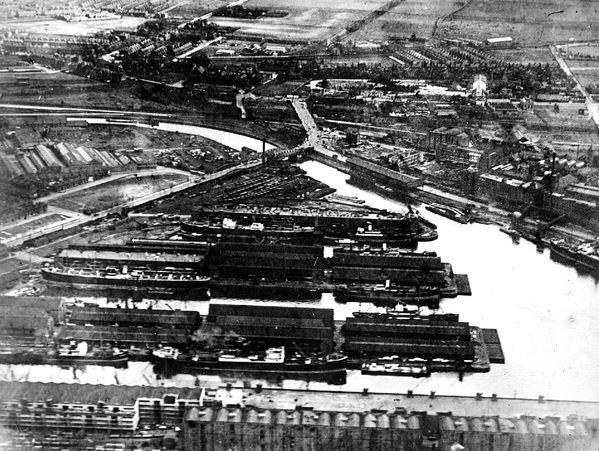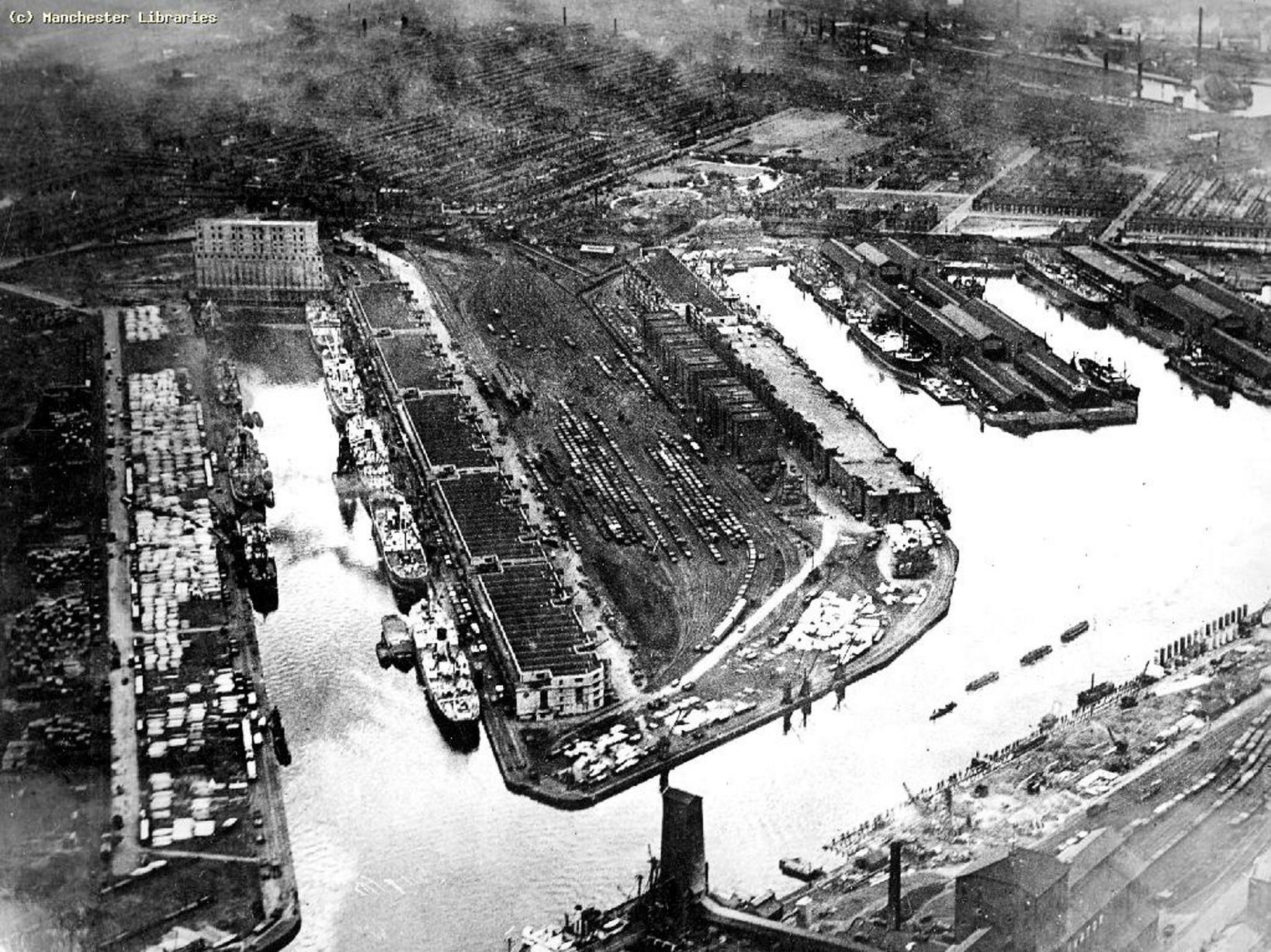Welcome to Salford Quays! You are standing in a significant historical area that allowed Manchester to grow during the 19th and 20th centuries and which helped make it one of the world's most important industrial cities.
Today, take a moment to look around. Behind you is The Lowry - a theatre and art gallery complex. Round to the left you can see Manchester United's Stadium at Old Trafford. Ahead is the angular building of the Imperial War Museum North, and beyond that the ITV studios site of Coronation Street. To your right is MediaCityUK - not only a new studio complex home to many famous TV programmes, but also BBC and ITV's offices and broadcast facilities. The University of Salford's media campus is also there, along with many other production companies and resources (as well as the Blue Peter Garden!). Return to look ahead again though - and you'll see the most important thing of all - the Manchester Ship Canal.
Salford Quays was formerly known as the western part of Manchester Docks (also known as Salford Docks) and was built where the Manchester Ship Canal met the River Irwell. The Irwell was already a busy waterway snaking its way through Salford and Manchester, but by joining the Ship Canal linking it to the Mersey it made the world's markets available to traders bypassing Liverpool, and allowing trading independence.

Manchester Docks, 1922 (Manchester Libraries). You are looking at docks 6, 7 and 8 (from the top). You can just about see Manchester United's Old Trafford ground in above middle right of the picture - they moved to Old Trafford in 1910. The river Irwell can be seen flowing from the top left into the Ship Canal.
It is easy to underestimate the significance of this area. The docks helped Manchester grow to be the dominant port of the North for import and export of cotton goods in particular. The ship canal opened in 1894, and at its height, the port was the third-busiest port in the UK. As well as the linen and cotton, grain and meat was imported, and heavy engineering such as steam locomotives, industrial cables, boilers and all sorts of hardware was manufactured in Manchester and exported. It all left through here, enabling the Empire to expand in the industrial age from the turn of the 20th century for nearly 90 years.
Even prior to the opening of the Ship Canal, Manchester was a dominant force in cotton goods export. Its cotton trade contributed 50% of British exports in the 1830s, rising to 80% of global cotton piece goods in the 1880s.
According to wikipedia, "In 1907–1908 about half of the [mostly Egyptian] cotton used in Lancashire cotton mills passed through the port, about 216,570 bales." At the same time, the amount of grain passing through the docks increased tenfold.
Even today across the world - particularly in Australia and New Zealand - aisles in supermarkets say 'Manchester' above them, referring to linen goods (towels, sheets etc. Historically, crates and deliveries of these goods had 'Manchester' stamped on them so it became a nickname for all cotton fabrics in the local parlance.
A Manchester based shipping line, Manchester Liners was based in Manchester docks - formed to avoid the cartel of Liverpool ship owners and provide direct access to Manchester. It has a long and varied history, being founded in 1898, but much of its daily work until the 1960s was exporting cotton goods across the Atlantic and importing meat and grain. Post 1960 the transition to containerised goods became much of its service until its decline in the 1980s.
The decline of the docks in general mirrored the fortunes of Manchester Liners. In a new world of containerised shipping, the larger container and freight ships weren't able to travel up the Manchester Ship Canal and, with the decline in engineering and cotton exports, the Port of Manchester closed in 1982. The dockyards lay derelict, but over the following decades Salford Council and other investors and companies invested in the 'Salford Quays' model, building on a vision to reuse the brownfield site as a focus for entertainment, residential and businesses, cleaning the previously industrially polluted water, and regenerating the area.

Dock 9 (Manchester Libraries), possibly 1950s. The main dock on the left is dock 9; the left hand bank is where Media City is now. You are standing on the 'pointy' bit at the bottom middle of the image, beneath the warehouses and railway sidings, next to where the Lowry is now. The Imperial War Museum and ITV Coronation Street set are on the bank off the bottom of the picture.
There's a wealth of history written and recorded about the Ship Canal and Manchester Docks as it was essentially what transformed Manchester from a medium sized city to the centre of the cotton and industrial revolution in the north. If you're interested in seeing and reading more, there's a couple of fantastic films available free to watch on the BFI site.
Firstly, a 12 minute documentary from 1962, which gives an overview of the canal and the docks in their heyday: Manchester Ship Canal 1962
There's also this 26 minute silent film of footage of the Ship Canal dating from 1924, which gives a great flavour of the busyness of the docks, railways and ships loading and unloading a hundred years ago. Of particular interest might be Barton swing aqueduct at 11.00, iron ore being transported by rail at 12.40, and unloading raw Egyptian and American cotton from 17.30. 1924 B&W footage of Manchester Ship canal
.
Finally, another silent one from about the same time which has a lot of the docks and Trafford Park Railway: Canal and docks from the 20s? B&W
For yet more further reading - Manchester's Central Library has many books and resources on the history of Manchester and its trading routes. In the first instance though, here's some links for interest:
Wikipedia - Manchester Docks
Wikipedia - Salford Quays
Wikipedia - Manchester Ship Canal
Wikipedia - Port of Manchester
Wikipedia - Manchester Liners
To log this virtual cache:
- 1) Near GZ is one of the Sculptures you'll find around Salford Quays - "Where the Wild Things Were" - there are several blades of Elephant Grass. You can read about the sculpture on the nearby plaque.
Each of these blades have engraved on them imaginative descriptions about the far-off lands that were once connected to the docks. For example, one of them begins:
"All the trees are taller than the cranes..."
Your task is to find the missing words from the first lines of two of the other blades of grass:
"There are some that are bigger than a XXXXXXX"
"I saw one with a belly as round as a YYYYYYYY"
The missing words, XXXXXXX YYYYYYYY describe an amusing animal-based sport. Please put this sport in the subject of an email to me at GC890BD@scandrett.net (and include your username in the body of the email!). Geocaching Direct Messages are also OK.
There's no need to wait for any response before logging the cache after sending this.
- 2) Stand at GZ and imagine the hustle and bustle of the ships unloading, the railway wagons being filled, the warehouses towering above, and the cranes operating all around you in this area. Ships and boats coming and going, men transferring cargo to and from distant destinations, and the raw materials arriving and finished linen and cotton products being exported that gave Manchester its nickname of Cottonopolis. It was a noisy, dirty but industrious time. How does it make you feel? Do you feel connected to the past here? Perhaps write some of your thoughts in your log.
- 3) Optional - take a photo of yourself at GZ overlooking the docks as they are today, and post your picture for all to see!
Well done to Hydeseeker for their FTF!
Virtual Rewards 2.0 - 2019/2020
This Virtual Cache is part of a limited release of Virtuals created between June 4, 2019 and June 4, 2020. Only 4,000 cache owners were given the opportunity to hide a Virtual Cache. Learn more about Virtual Rewards 2.0 on the Geocaching Blog.